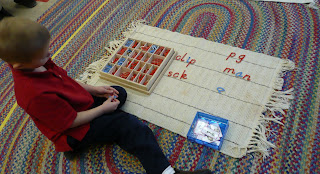
Here are my disciples, finished, except for the finish coat and a cushioned storage box.





 The girl in front is in her second year in the Children's House. She learned to write numbers last year and is now making a "Number Roll". On long sheets of grid paper, she writes each number in order, beginning with "1". One of our returning students has already reached 300!
The girl in front is in her second year in the Children's House. She learned to write numbers last year and is now making a "Number Roll". On long sheets of grid paper, she writes each number in order, beginning with "1". One of our returning students has already reached 300! This child is working with the "Geometry Cabinet", a series of drawers containing shapes arranged by category. This one is the rectangle drawer. He is matching the various rectangles to a series of cards with the same shape either filled in, or outlined with a thin line or a thick line. This work develops visual perception of size and shape, develops the sense of order, and prepares the mind for further work in geometry. The child is also introduced to the names of the various geometric shapes.
This child is working with the "Geometry Cabinet", a series of drawers containing shapes arranged by category. This one is the rectangle drawer. He is matching the various rectangles to a series of cards with the same shape either filled in, or outlined with a thin line or a thick line. This work develops visual perception of size and shape, develops the sense of order, and prepares the mind for further work in geometry. The child is also introduced to the names of the various geometric shapes.

 One of the big areas in the Montessori Children's House curriculum is Language. By this we mean the whole realm of learning to express oneself and communicate with others, both orally and in the written form. When I came down to selecting the photos for this topic, I realized that absolutely everything in our room is related in some way to this all-important area of human development. Every parent is concerned that their children learn how to read and write. The Montessori program does that very well, and in such a natural, individualized way that the child barely knows he or she is working on it.
One of the big areas in the Montessori Children's House curriculum is Language. By this we mean the whole realm of learning to express oneself and communicate with others, both orally and in the written form. When I came down to selecting the photos for this topic, I realized that absolutely everything in our room is related in some way to this all-important area of human development. Every parent is concerned that their children learn how to read and write. The Montessori program does that very well, and in such a natural, individualized way that the child barely knows he or she is working on it. Here, two younger students are observing an older child read words and match them to the corresponding objects. Observation is one of the best ways of learning, and is lent the dignity of being called, "Observation Work".
Here, two younger students are observing an older child read words and match them to the corresponding objects. Observation is one of the best ways of learning, and is lent the dignity of being called, "Observation Work". This child is doing "Vocabulary Cards". The cards show pictures of things in everyday life. The child learns the words for them and then can tell a story using the cards.
This child is doing "Vocabulary Cards". The cards show pictures of things in everyday life. The child learns the words for them and then can tell a story using the cards.
 Listening to a book on CD.
Listening to a book on CD. Finding objects in the room that match specific colors.
Finding objects in the room that match specific colors. Matching fabrics by textures and grading then from smoothest to roughest.
Matching fabrics by textures and grading then from smoothest to roughest. Many activities serve as indirect prepartion for writing by developing in the muscles of the hand the strength and coordination needed for writing. Here, bead stringing serves this purpose.
Many activities serve as indirect prepartion for writing by developing in the muscles of the hand the strength and coordination needed for writing. Here, bead stringing serves this purpose. Carefully balancing the Brown Stair prisms to make a design.
Carefully balancing the Brown Stair prisms to make a design. Sewing is excellent for the development of the fine muscles, also for left to right orientation and sequencing.
Sewing is excellent for the development of the fine muscles, also for left to right orientation and sequencing.
 Even cleaning the easle is taught in a series of ordered steps from left to right. This serves as preparation for reading and writing.
Even cleaning the easle is taught in a series of ordered steps from left to right. This serves as preparation for reading and writing. Cutting bread. Yikes! You give children knifes and needles? Yes, we do, along with instructions for their proper use.
Cutting bread. Yikes! You give children knifes and needles? Yes, we do, along with instructions for their proper use.

 Polishing and cutting, and pouring.
Polishing and cutting, and pouring.



 Then, we write on a chalk board (also easy to erase, but uses a tool-chalk).
Then, we write on a chalk board (also easy to erase, but uses a tool-chalk).
 This child is tracing names of class members.
This child is tracing names of class members.

 Then the Sandpaper Letters are matched to the corresponding letters from
Then the Sandpaper Letters are matched to the corresponding letters from Then the child can start sounding out words and "writing" them with the Movable Alphabet. At this point, finding the sounds that make up a word, encoding, usually comes before reading, or decoding.
Then the child can start sounding out words and "writing" them with the Movable Alphabet. At this point, finding the sounds that make up a word, encoding, usually comes before reading, or decoding. The Movable Alphabet makes it possible to "write" words before one has the fine muscle coordination to write them with pencil and paper. Often the child, after doing this exercise, will choose to record the words on paper by copying them from their mat.
The Movable Alphabet makes it possible to "write" words before one has the fine muscle coordination to write them with pencil and paper. Often the child, after doing this exercise, will choose to record the words on paper by copying them from their mat. First time actually reading: This child is reading words and matching them to the corresponding objects. Then he writes each word on its own little ticket and puts them together to make a "book".
First time actually reading: This child is reading words and matching them to the corresponding objects. Then he writes each word on its own little ticket and puts them together to make a "book".
 This student is working on recognizing "Puzzle Words", common words that do not follow the phonetic rules.
This student is working on recognizing "Puzzle Words", common words that do not follow the phonetic rules. This student is writing words with the phonogram "kn".
This student is writing words with the phonogram "kn". The Hundred Board, officially in the Math area, contributes to the skills of scanning and ordering, which are neccesary for reading.
The Hundred Board, officially in the Math area, contributes to the skills of scanning and ordering, which are neccesary for reading. An advanced Hundred Board work involving skip counting, helps with the skills of left to right orientation and scanning across a line.
An advanced Hundred Board work involving skip counting, helps with the skills of left to right orientation and scanning across a line. The Thousand Chain works on the same skills in a popular variation.
The Thousand Chain works on the same skills in a popular variation.
 Making a map of the continents helps with shape recognition and fine muscle develpoment.
Making a map of the continents helps with shape recognition and fine muscle develpoment. Making constructions with the Brown Stair and Pink Tower helps develop the reading skill of noticing patterns and order.
Making constructions with the Brown Stair and Pink Tower helps develop the reading skill of noticing patterns and order.